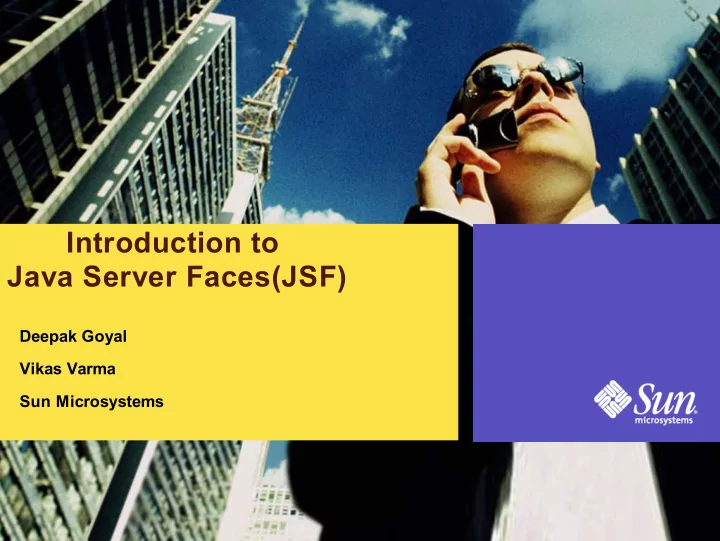

Introduction to Java Server Faces(JSF) Deepak Goyal Vikas Varma Sun Microsystems
Objective Understand the basic concepts of Java Server™ Faces[JSF] Technology. 2
Agenda What is and why JSF? Architecture Overview UI Component Model Development Steps
JavaServer ™ Faces (JSF) Framework Is… A server side user interface component framework for Java™ technology-based web applications 4
What is JSF? ● A specification and reference implementation for a web application development framework – Components – Events – Validators & converters – Navigation – Back-end-data integration 5
Why JSF? (page 1) ● MVC for web applications ● Clean separation of roles ● Easy to use ● Extendable Component and Rendering architecture ● Support for client device independence ● Standard ● Huge vendor and industry support 6
Why JSF? (page 2) ● JSP and Servlet – No built-in UI component model ● Struts (I am not saying you should not use Struts) – No built-in UI component model – No built-in event model for UI components – No built-in state management for UI components – No built-in support of multiple renderers – Not a standard (despite its popularity) ● Struts and JSF can be used together 7
How the JSF Specification Fits In JSF App JSF App JSF Tags JSP (1.2) JSF API Servlets (2.3) 8
Agenda What is and why JSF? Architecture Overview UI Component Model Development Steps
JSF Architecture [MVC] Server JSF Page HTML Desktop HTML Browser RenderKit Front App ctrl Backend JSF Page WML RenderKit Phone WML 10
Request processing Lifecycle FacesServlet 2.Passes controls to Lifecycle 1.Creates FacesContext Lifecycle FacesContext 3. Process FacesContext in various phase
Request Processing Lifecycle Phases Faces Request Reconstitute Apply Process Component Request Validations Tree Values Faces Update Response Render Invoke Model Response Application Values 12
Request Processing Lifecycle Response Response Complete Complete Faces Request Reconstitute Apply Process Process Process Component Request Events Validations Events Tree Values Render Response Response Response Complete Complete Faces Update Response Render Process Invoke Process Model Responder Events Application Events Values Conversion Errors / Render Response Validation / Conversion Errors / Render Response 13
Request Processing Lifecycle Phases 1.Reconstitute component tree phase 2.Apply request values phase 3.Process validations phase 4.Update model values phase 5.Invoke application phase 6.Render response phase 14
Agenda What is and why JSF? Architecture Overview UI Component Model Development Steps
User Interface Component Model ● UI components ● Event handling model ● Conversion and Validation model ● Rendering model ● Page navigation support 16
UI Components UIComponent/UIComponentBase Base class for all user interface components Standard UIComponent Subclasses UICommand, UIForm, UIOutput UIGraphic, UIInput, UIPanel, UIParameter UISelectBoolean, UISelectMany, UISelectOne Example: <h:inputText id="userNo" value="#{UserNumberBean.userNumber}"/>
Validators and Converters Validators—Perform correctness checks on UIInput values Register one or more per component Enqueue one or more messages on errors Standard implementations for common cases Converters—Plug-in for conversions: Output: Object to String Input: String to Object Standard implementations for common cases
Converters and Validators Example: Converters: <h:input_text valueRef=”testingBean.today” convertor=”DateTime”/> Validators: <h:input_text valueRef=”testingBean.today” <f:validator_length minimum=”6” maximum='10” />
Rendering Model Renderers- Adapt components to a specific markup language Decoding Encoding RenderKits—Library of Renderers Map component classes to component tags Is a custom tag library Basic HTML RenderKit
Events and Listeners Follows JavaBeans™ Specification design and naming patterns Standard events and listeners ActionEvent— UICommand component activated by the user ValueChangedEvent— UIInput component whose value was just changed
Navigation Model Application developer responsibility Defined in Application configuration file (Facesconfig.xml) Navigation rules Determine which page to go. Navigation case
Navigation Model <navigation-rule> <from-tree-id>/login.jsp</from-tree-id> <navigation-case> <from-outcome>success</from-outcome> <to-tree-id>/menu.jsp</to-tree-id> </navigation-case> <navigation-case> <from-outcome>failed</from-outcome> <to-tree-id>/error.jsp</to-tree-id> </navigation-case> </navigation-rule>
Agenda What is and why JSF? Architecture Overview UI Component Model Development Steps
Steps in Development Process 1. Develop model objects which hold the data 2. Add model objects (managed bean) declarations to Application Configuration File faces-config.xml 3. Create Pages using UI component and core tags 4. Define Page Navigation in faces-config.xml 5. Configure web.xml
Step1: Develop model Objects (Managed Bean) The model (M) in MVC A regular JavaBeans with read/write properties May contain application methods and event handlers Use to hold data from a UI (page) Creation and lifetime is managed by JSF runtime application, session, request JSF keeps the bean's data in sync with the UI
Step 2. Managed Bean Declaration (Faces-config.xml) 01 <managed-bean> 02 <managed-bean-name> 03 LoginFormBean 04 </managed-bean-name> 05 <managed-bean-class> 06 myapp.LoginFormBean 07 </managed-bean-class> 08 <managed-bean-scope> 09 request 10 </managed-bean-scope> 11 </managed-bean>
Step 3: Create JSF Pages Must include JSF tag library HTML and core tags All JSF tags must enclosed between a set of view tag Use JSF form and form component tags <h:input_text> not <input type=”text”> <h:command_button> not <input type=”submit”> May include validators and event listeners on any form components
Sample JSF™ Page (login.jsp) 01 <f:view> 02 <f:form formName=”logonForm”> 03 <h:panel_grid columns=”2”> 04 <h:output_text value=”Username:”/> 05 <h:input_text id=”username” length=”16” 06 valueRef=”logonBean.username”/> 07 <h:output_text value=”Password:”/> 08 <h:input_secret id=”password” length=”16” 09 valueRef=”logonBean.password”/> 10 <h:command_button type=”submit” 11 label=”Log On” 12 actionRef=”logonBean.logon”/> 13 <h:command_button type=”reset” 14 label=”Reset”/> 15 </h:panel_grid> 16 </f:form> 17 </f:view>
Binding UI to Managed Bean login.jsp <h:input_text id=”userName” valueRef=”LoginFormBean.userName”/> LoginFormBean.java faces-config.xml <managed-bean> public class LoginFormBean <managed-bean-name> ... LoginFormBean public void </managed-bean-name> setUserName(...) { <managed-bean-class> public String myapp.LoginFormBean getUserName(...) { </managed-bean-class>
Step 4: Define Page Navigation Rules (Faces-config.xml) 01 <navigation-rule> 02 <from-tree-id>/login.jsp</from-tree-id> 03 <navigation-case> 04 <from-outcome>success</from-outcome> 05 <to-tree-id>/menu.jsp</to-tree-id> 06 </navigation-case> 07 </navigation-rule> 08 09 <navigation-rule> 010 <from-tree-id>/login.jsp</from-tree-id> 011 <navigation-case> 012 <from-outcome>failure</from-outcome> 013 <to-tree-id>/error.jsp</to-tree-id> 014 </navigation-case> 015 </navigation-rule>
Step 5: Configure (web.xml) 01 <context-param> 02 <param-name> 03 javax.faces.application.CONFIG_FILES 04 </param-name> 05 <param-value>/WEB-INF/faces-config.xml 06 </param-value> 07 </context-param> 08 <servlet> 09 <servlet-name>Faces Servlet</servlet-name> 10 <servlet-class> 11 javax.faces.webapp.FacesServlet</servlet-class> 12 <load-on-startup> 1 </load-on-startup> 13 </servlet> 14 <!-- Faces Servlet Mapping --> 15 <servlet-mapping> 16 <servlet-name>Faces Servlet</servlet-name> 17 <url-pattern>/faces/*</url-pattern> 18 </servlet-mapping>
Recommend
More recommend